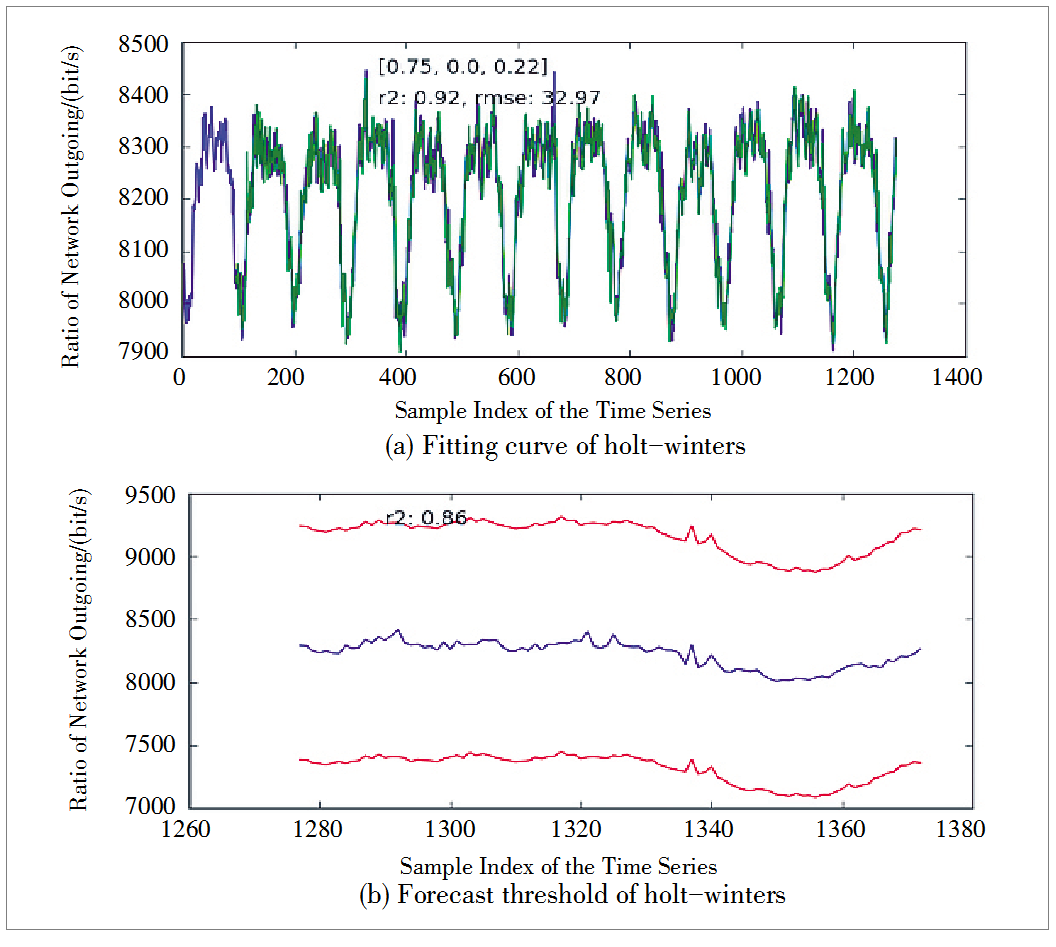ZTE Communications ›› 2019, Vol. 17 ›› Issue (4): 19-26.DOI: 10.12142/ZTECOM.201904004
• Special Topic • Previous Articles Next Articles
LIU Jianwei( ), YUAN Yifei, HAN Jing
), YUAN Yifei, HAN Jing
Received:2019-09-30
Online:2019-12-25
Published:2020-04-16
About author:LIU JianweiSupported by:LIU Jianwei, YUAN Yifei, HAN Jing. A Case Study on Intelligent Operation System for Wireless Networks[J]. ZTE Communications, 2019, 17(4): 19-26.
Add to citation manager EndNote|Ris|BibTeX
URL: http://zte.magtechjournal.com/EN/10.12142/ZTECOM.201904004

Figure 5 An illustration of time series modeling by Holt-Winters: (a) represents the true value (blue curve) and fitting value (green curve) in historical data; (b) represents the true value (blue curve) and the predicted thresholds (red curve) in the following day.
| 1 |
MITRA R N,AGRAWAL D P.5G Mobile Technology: A Survey [J].ICT Express,2015,1(3):132–137.DOI:10.1016/j.icte.2016.01.003
DOI |
| 2 |
C⁃LI,HAN S,XU Z,et al.New Paradigm of 5G Wireless Internet [J].IEEE Journal on Selected Areas in Communications,2016,34(3):474–482.DOI:10.1109/JSAC.2016.2525739
DOI |
| 3 |
PARK T,ABUZAINAB N,SAAD W.Learning How to Communicate in the Internet of Things: Finite Resources and Heterogeneity [J].IEEE Access,2016,4:7063–7073.DOI:10.1109/ACCESS.2016.2615643
DOI |
| 4 |
SOLDANI D,MANZALINI A.Horizon 2020 and Beyond: On the 5G Operating System for a True Digital Society [J].IEEE Vehicular Technology Magazine,2015,10(1):32–42.DOI:10.1109/MVT.2014.2380581
DOI |
| 5 |
IMRAN A,ZOHA A,ABU⁃DAYYA A.Challenges in 5G: How to Empower SON with Big Data for Enabling 5G [J].IEEE Network,2014,28(6):27–33.DOI:10.1109/MNET.2014.6963801
DOI |
| 6 |
KIBRIA M G,NGUYEN K,VILLARDI G P,et al.Big Data Analytics, Machine Learning, and Artificial Intelligence in Next⁃Generation Wireless Networks [J].IEEE Access,2018,6:32328–32338.DOI:10.1109/ACCESS.2018.2837692
DOI |
| 7 |
LONG F,LI N,WANG Y X.Autonomic Mobile Networks: the Use of Artificial Intelligence in Wireless Communications [C]//2nd International Conference on Advanced Robotics and Mechatronics (ICARM).New York, USA:IEEE,2017:582–586.DOI:10.1109/ICARM.2017.8273227
DOI |
| 8 |
JIANG C X,ZHANG H J,REN Y,et al.Machine Learning Paradigms for Next⁃Generation Wireless Networks [J].IEEE Wireless Communications,2016,24(2):98–105.DOI:10.1109/MWC.2016.1500356WC
DOI |
| 9 |
FENG V⁃S,CHANG S Y.Determination of Wireless Networks Parameters Through Parallel Hierarchical Support Vector Machines [J].IEEE Transactions on Parallel and Distributed Systems,2011,23(3):505–512.DOI:10.1109/TPDS.2011.156
DOI |
| 10 |
XIA M,OWADA Y,INOUE M,et al.Optical and Wireless Hybrid Access Networks: Design and Optimization [J].Journal of Optical Communications and Networking,2012,4(10):749–759.DOI:10.1364/JOCN.4.000749
DOI |
| 11 |
ALNWAIMI G,VAHID S,MOESSNER K.Dynamic Heterogeneous Learning Games for Opportunistic Access in LTE⁃Based Macro/Femtocell Deployments [J].IEEE Transactions on Wireless Communications,2014,14(4):2294–2308.DOI:10.1109/TWC.2014.2384510
DOI |
| 12 |
MENG Z H,LIU J W,HAN J.Time Series Clustering Based on Structural Features [J].ZTE Technology Journal,2018,24(03):61–66.DOI:10.3969/j.issn.1009⁃6868.2018.03.011
DOI |
| 13 |
LAPTEV N,AMIZADEH S,FLINT I.Generic and Scalable Framework for Automated Time⁃Series Anomaly Detection [C]//Proceedings of the 21th ACM SIGKDD International Conference on Knowledge Discovery and Data Mining.New York, USA:ACM,2015:1939–1947.DOI:10.1145/2783258.2788611
DOI |
| 14 |
LI G,QIN S⁃Z,JI Y⁃D,et al.Total PLS Based Contribution Plots for Fault Diagnosis [J].Acta Automatica Sinica,2009,35(6):759–765.DOI:10.1016/S1874⁃1029(08)60094⁃4
DOI |
| 15 |
DANG Y N,LIN Q W,HUANG P.AIOps: Real⁃World Challenges and Research Innovations[C]//Proceedings of the 41st International Conference on Software Engineering: Companion Proceedings.New York, USA:IEEE Press,2019:4–5.DOI:10.1109/ICSE-Companion.2019.00023
DOI |
| [1] | LI Hanwen, BI Ningjing, SHA Jin. Design of Raptor-Like LDPC Codes and High Throughput Decoder Towards 100 Gbit/s Throughput [J]. ZTE Communications, 2023, 21(3): 86-92. |
| [2] | DING Jianwen, LIU Yao, LIAO Hongjian, SUN Bin, WANG Wei. Statistical Model of Path Loss for Railway 5G Marshalling Yard Scenario [J]. ZTE Communications, 2023, 21(3): 117-122. |
| [3] | CHEN Jiajun, GAO Yin, LIU Zhuang, LI Dapeng. Future Vision on Artificial Intelligence Assisted Green Energy Efficiency Network [J]. ZTE Communications, 2023, 21(2): 34-39. |
| [4] | AWADA Uchechukwu, ZHANG Jiankang, CHEN Sheng, LI Shuangzhi, YANG Shouyi. Machine Learning Driven Latency Optimization for Internet of Things Applications in Edge Computing [J]. ZTE Communications, 2023, 21(2): 40-52. |
| [5] | SHI Xiangyi, HAN Tongzhou, TIAN Hai, ZHAO Danfeng. Design of Raptor-Like Rate Compatible SC-LDPC Codes [J]. ZTE Communications, 2022, 20(S1): 16-21. |
| [6] | ZHAO Zipiao, ZHAO Yongli, YAN Boyuan, WANG Dajiang. Auxiliary Fault Location on Commercial Equipment Based on Supervised Machine Learning [J]. ZTE Communications, 2022, 20(S1): 7-15. |
| [7] | NAN Yucen, FANG Minghao, ZOU Xiaojing, DOU Yutao, Albert Y. ZOMAYA. A Collaborative Medical Diagnosis System Without Sharing Patient Data [J]. ZTE Communications, 2022, 20(3): 3-16. |
| [8] | ZHANG Jintao, HE Zhenqing, RUI Hua, XU Xiaojing. Spectrum Sensing for OFDMA Using Multicarrier Covariance Matrix Aware CNN [J]. ZTE Communications, 2022, 20(3): 61-69. |
| [9] | ZHANG Qixun, HAN Jing, CHENG Li, ZHANG Baisheng, GONG Zican. Approach to Anomaly Detection in Microservice System with Multi- Source Data Streams [J]. ZTE Communications, 2022, 20(3): 85-92. |
| [10] | HOU Xiaolin, LI Xiang, WANG Xin, CHEN Lan, SUYAMA Satoshi. Some Observations and Thoughts about Reconfigurable Intelligent Surface Application for 5G Evolution and 6G [J]. ZTE Communications, 2022, 20(1): 14-20. |
| [11] | YAN Xincheng, TENG Huiyun, PING Li, JIANG Zhihong, ZHOU Na. Study on Security of 5G and Satellite Converged Communication Network [J]. ZTE Communications, 2021, 19(4): 79-89. |
| [12] | LIU Haipeng, ZHANG Xingyue, ZHOU Anfu, LIU Liang, MA Huadong. Indoor Environment and Human Sensing via Millimeter Wave Radio: A Review [J]. ZTE Communications, 2021, 19(3): 22-29. |
| [13] | HAN Jing, JIA Tong, WU Yifan, HOU Chuanjia, LI Ying. Feedback‑Aware Anomaly Detection Through Logs for Large‑Scale Software Systems [J]. ZTE Communications, 2021, 19(3): 88-94. |
| [14] | XIAO Kai, LIU Xing, HAN Xianghui, HAO Peng, ZHANG Junfeng, ZHOU Dong, WEI Xingguang. Flexible Multiplexing Mechanism for Coexistence of URLLC and EMBB Services in 5G Networks [J]. ZTE Communications, 2021, 19(2): 82-90. |
| [15] | LIU Zhuang, GAO Yin, LI Dapeng, CHEN Jiajun, HAN Jiren. Enabling Energy Efficiency in 5G Network [J]. ZTE Communications, 2021, 19(1): 20-29. |
| Viewed | ||||||
|
Full text |
|
|||||
|
Abstract |
|
|||||